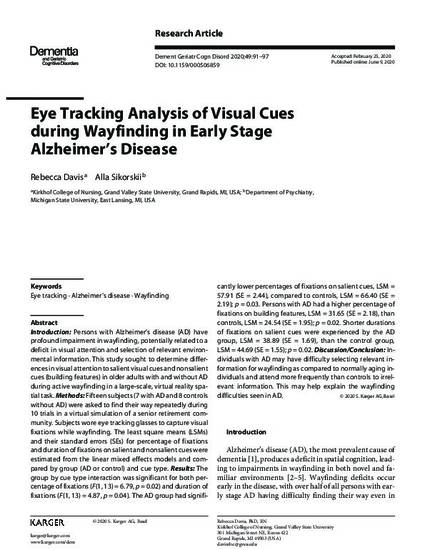
Article
Eye Tracking Analysis of Visual Cues during Wayfinding in Early Stage Alzheimer’s Disease
Dementia and Geriatric Cognitive Disorders
(2020)
Abstract
Introduction: Persons with Alzheimer’s disease (AD) have
profound impairment in wayfinding, potentially related to a
deficit in visual attention and selection of relevant environmental
information. This study sought to determine differences
in visual attention to salient visual cues and nonsalient
cues (building features) in older adults with and without AD
during active wayfinding in a large-scale, virtual reality spatial
task. Methods: Fifteen subjects (7 with AD and 8 controls
without AD) were asked to find their way repeatedly during
10 trials in a virtual simulation of a senior retirement community.
Subjects wore eye tracking glasses to capture visual
fixations while wayfinding. The least square means (LSMs)
and their standard errors (SEs) for percentage of fixations
and duration of fixations on salient and nonsalient cues were
estimated from the linear mixed effects models and compared
by group (AD or control) and cue type. Results: The
group by cue type interaction was significant for both percentage
of fixations (F(1, 13) = 6.79, p = 0.02) and duration of
fixations (F(1, 13) = 4.87, p = 0.04). The AD group had significantly
lower percentages of fixations on salient cues, LSM =
57.91 (SE = 2.44), compared to controls, LSM = 66.40 (SE =
2.19); p = 0.03. Persons with AD had a higher percentage of
fixations on building features, LSM = 31.65 (SE = 2.18), than
controls, LSM = 24.54 (SE = 1.95); p = 0.02. Shorter durations
of fixations on salient cues were experienced by the AD
group, LSM = 38.89 (SE = 1.69), than the control group,
LSM = 44.69 (SE = 1.55); p = 0.02. Discussion/Conclusion: Individuals
with AD may have difficulty selecting relevant information
for wayfinding as compared to normally aging individuals
and attend more frequently than controls to irrelevant
information. This may help explain the wayfinding
difficulties seen in AD.
Keywords
- Eye trackuing,
- Alzheimer's disease,
- wayfinding
Disciplines
Publication Date
Spring June 9, 2020
DOI
10.1159/000506859
Citation Information
Rebecca Davis and Alla Sikorskii. "Eye Tracking Analysis of Visual Cues during Wayfinding in Early Stage Alzheimer’s Disease" Dementia and Geriatric Cognitive Disorders Vol. 49 Iss. 1 (2020) p. 91 - 97 ISSN: 1420-8008 Available at: http://works.bepress.com/rebecca-l-davis/10/
